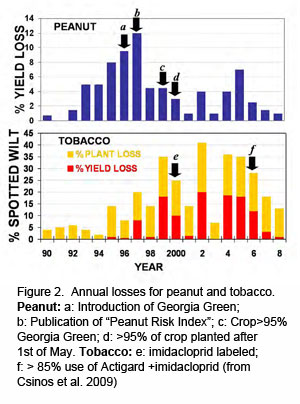 Spotted wilt losses in peanut are based on a consensus estimate from each of the scientists (plant pathology, entomology and agronomy) involved in the annual evaluation of the spotted wilt risk index for peanut (5). Annual losses based on these estimates are shown in the figure at right. The sharp declines in losses after 1997 are due to the implementation of a highly effective management program based principally on resistant varieties and planting date.
Spotted wilt losses in peanut are based on a consensus estimate from each of the scientists (plant pathology, entomology and agronomy) involved in the annual evaluation of the spotted wilt risk index for peanut (5). Annual losses based on these estimates are shown in the figure at right. The sharp declines in losses after 1997 are due to the implementation of a highly effective management program based principally on resistant varieties and planting date.
Resistant varieties can reduce disease loss by 30%-75% for any planting date. Resistance-breaking strains of TSWV have not been found in peanut. However, the more current TSWV resistant peanut lines have better levels of resistance than those lines developed years ago. The loss cycle between 2001 and 2008, when the variety Georgia Green made up ~95% of the peanut acreage in Georgia, suggests partial resistance during this period and the resulting loss fluctuating with disease pressure. With partial resistance, other control tactics can become significant factors in mitigating the effects of this disease. For example, planting in May as opposed to April can result in a 40%-60% reduction of loss in susceptible to moderately resistant varieties. Other cultural practices offer additional additive disease reduction, particularly when April planting cannot be avoided (1, 2). In peanut, the use of quantifiable TSWV risk factors has become the standard approach for managing TSWV in other cropping systems and provides much of the foundation for the work done in this tomato-pepper project.
- Brown, S.L., J.W. Todd, A.K. Culbreath J.A. Baldwin, J.P. Beasley and H.R. Pappu. 1999. The Tomato Spotted Wilt Risk Index – Identifying and avoiding high risk situations. Univ. of Georgia Coop. Ext. Bull. 1165, Athens, GA.
- Brown, Steve L., A. K. Culbreath, J. W. Todd, D. W. Gorbet, John A. Baldwin, and John P. Beasley, Jr. 2005. Development of a method of risk assessment to facilitate integrated management of spotted wilt of peanut. Plant Dis. 89: 348-356.

